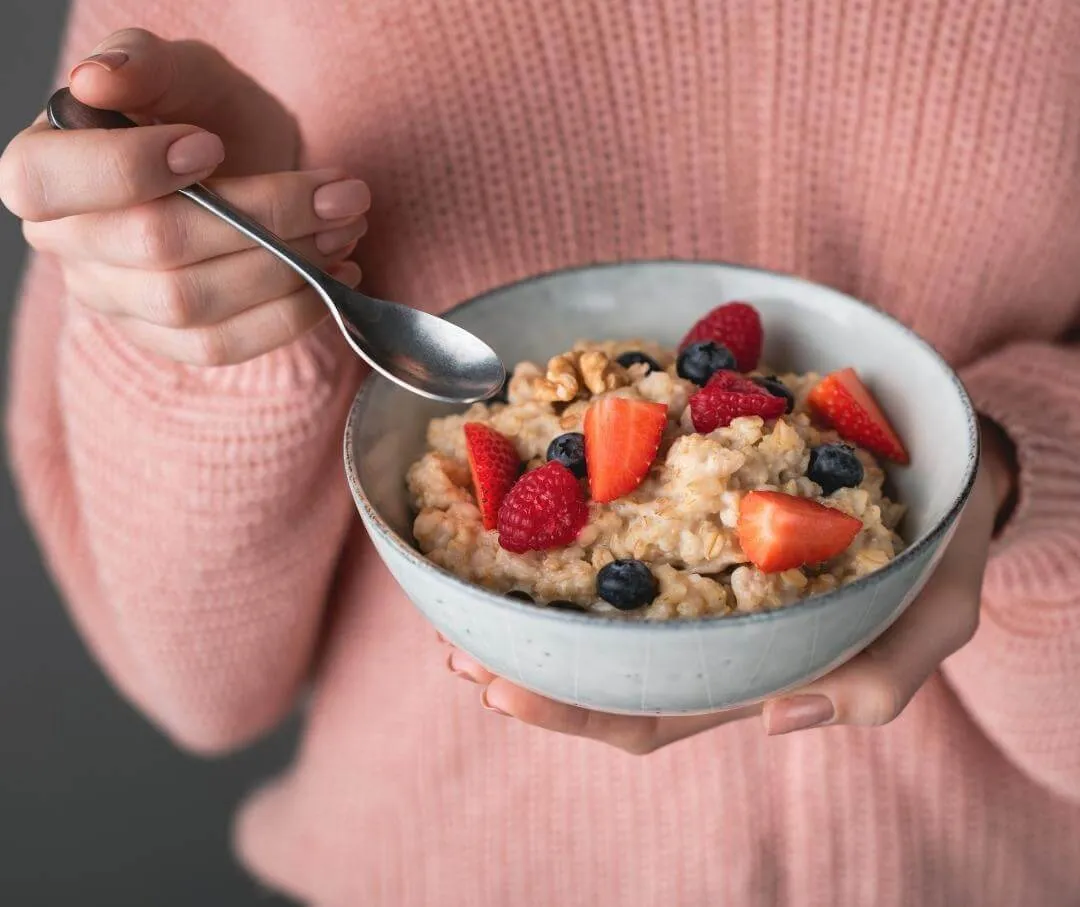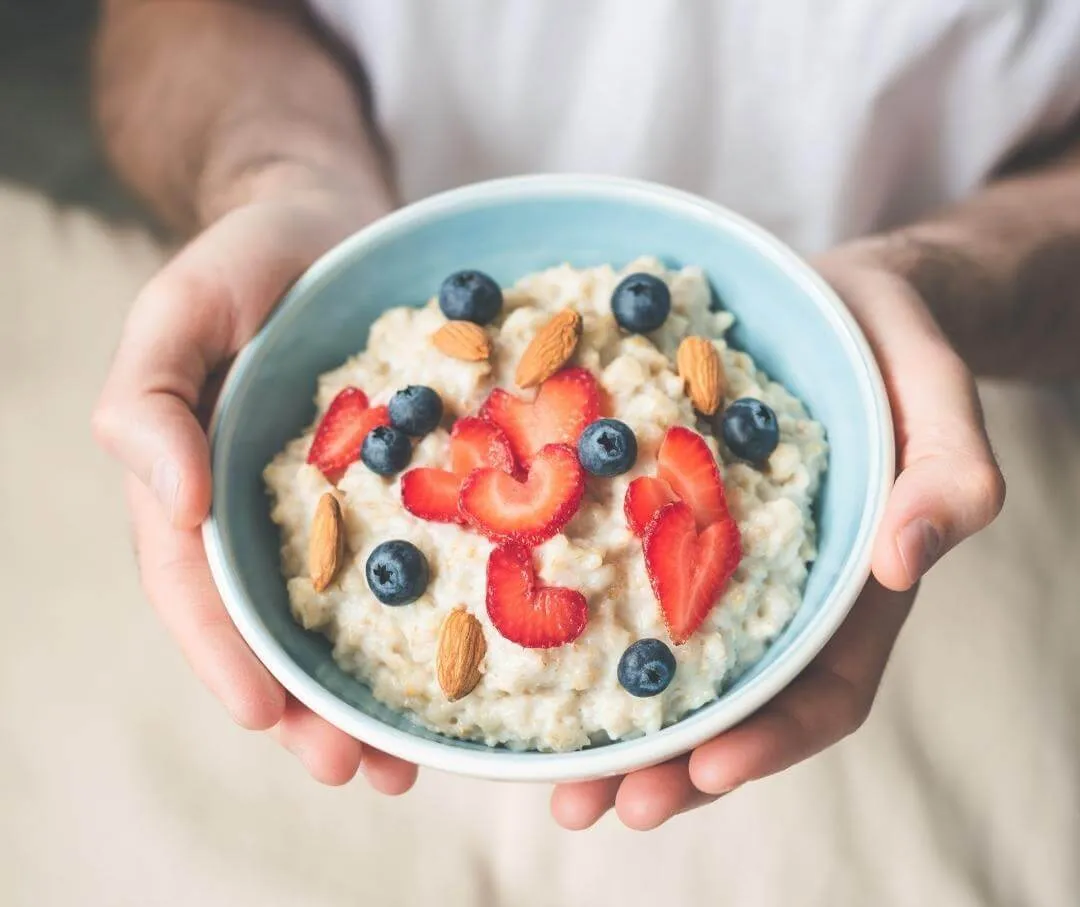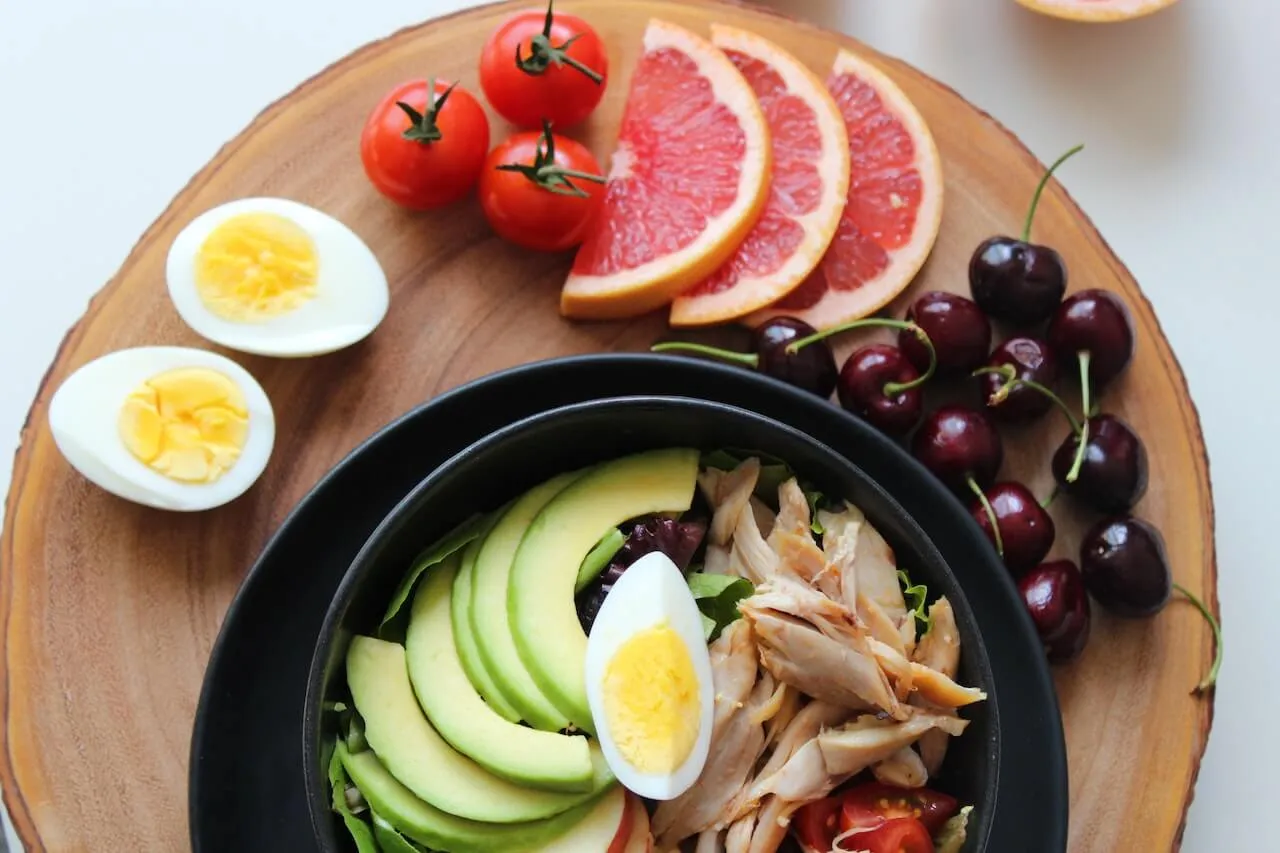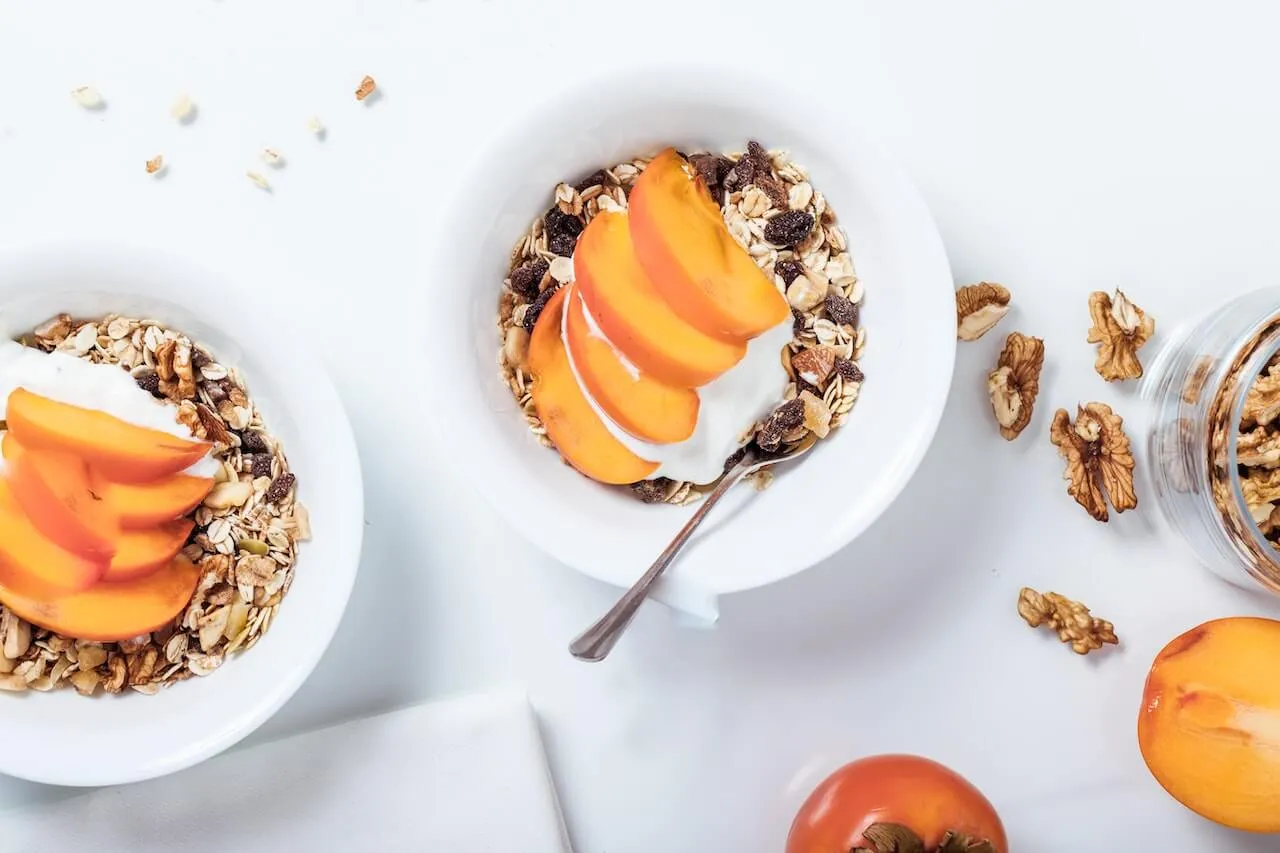Oatmeal is a low-fat, fiber-rich whole grain that contains about 6 grams of protein per serving. The soluble fiber in oatmeal is from beta-glucan which has been shown to help lower LDL cholesterol levels and helps stabilize blood glucose levels.1
The main functional ingredient in oats is beta glucan, present in both the soluble and insoluble fiber. Beta glucans are dietary fibers that are resistant to digestion and slow the rate of absorption of other carbohydrates. This helps reduce insulin levels and blood glucose, lowers blood cholesterol levels, and helps maintain body weight.2
A large systematic review looked at 16 studies that evaluated meals supplemented with oats and the effect on blood glucose, insulin levels, and lipid levels in people with type 2 diabetes. The review found that oat consumption reduced blood glucose levels, improved insulin sensitivity and improved lipid levels in people with type 2 diabetes.3
Another recent randomized study compared the blood glucose response on highly processed grains to less processed grains, including oats. Researches saw a 9% reduction in post-breakfast blood sugar levels and 6% decrease in blood sugar following other meals when less processed grains, including oats, were eaten.4
The fiber and protein in oats also have a satiating effect, helping to keep you feeling fuller longer. This can be helpful with weight management.
<p class="pro-tip"><strong>Learn more about </strong> <a href="/blog/oatmeal-weight-loss">oatmeal and weight loss</a>.</p>
Types of Oatmeal
There are a few different varieties of oatmeal available in grocery stores. Some are a bit more refined than others, but they also take longer to prepare. Which one is best depends a bit on how you intend to cook them and how much time you have.
Whole Oat Groats
Groats are the grain kernel after being harvested, washed and cleaned. The inedible outer layer has been removed but the kernel is kept intact. Groats will take about 30 minutes to cook on the stovetop. They are a great option for cooking in a slow cooker.

Steel Cut Oats
Steel-cut oats,also known as “Irish Oatmeal”, are groats that have been cut with a steel blade into smaller pieces. They will also take about a half hour to cook or overnight in a slow cooker. There are some varieties of “quick cooking” steel cut oats available, which just means they have been cut in smaller pieces so they cook faster.
Steel-cut oats are fairly low on the glycemic index scale (42) and have a little more fiber compared to rolled oats.5
1 serving of steel-cut oats contains about 150 calories, 27 grams of carbohydrates and 4 grams of fiber, 2 of which are soluble. They also contain 5 grams of protein.
Steel-cut oats keep their shape after being cooked and have a chewy texture.
<p class="pro-tip"><strong>Read about </strong> <a href="/blog/slow-digesting-carbs-and-blood-sugar-control">steel-cut oats and other slow-digesting carbs for blood sugar control</a>.</p>
Old-Fashioned Oats
Old-fashioned oats are made from the whole groat, cooked, and then rolled to flatten them into flakes. Old-fashioned oats take about 5 minutes to cook. They keep their shape after being cooked and have a slightly chewy texture. These oats are also often used in cookies and baked goods. They are also the best type to use when making overnight oats.
1 cup of cooked old-fashioned oats has 150 calories, 27 grams of carbohydrates, and 4 grams of fiber, 2 of which are soluble fiber. Old-fashioned oats are also low on the glycemic index scale falling around 55.5,6
<p class="pro-tip"><strong>Learn about </strong> <a href="/blog/fiber-for-metabolic-health">why fiber is so important for metabolic health</a>.</p>

Instant and Quick Oats
Rolled oats consist of old-fashioned oats, quick oats and instant oats. The difference between them is how thinly they are rolled, which affects how quickly they cook.
Quick oats are partially steamed then thinly rolled, so they are thinner than old-fashioned oats and will cook much quicker. Within a few minutes of boiling on the stovetop or warmed in the microwave, you will have a warm, delicious bowl of soft oatmeal.
Instant oats are the most refined types of oatmeal. Instant oats are processed the same way that old-fashioned and quick oats are, but are steamed longer and rolled even thinner. Because they are so thin, they cook in less than a minute. These are the oats you will typically find in individual packets for the microwave. They usually have added sugars and flavors, so be cautious when buying instant oats. These added ingredients can lead to a blood sugar spike that plain oats (or adding your own sweeteners and flavorings) may not cause.
Instant oatmeal, while still a whole grain, is higher in the glycemic index reported being as high as 83, compared to other forms of oatmeal. It is still a good source of fiber, and has the same nutrition as old-fashioned oats, with 1 cup of cooked oatmeal providing 4 grams of fiber, 2 grams of which is soluble.7
{{mid-cta}}
Benefits of Eating Oatmeal for Breakfast
While all oats contain a good source of fiber and have similar nutrition profiles, steel cut oats and old-fasioned oats are the lowest on the glycemic index scale. They both contain soluble fiber which helps lower LDL (bad) cholesterol levels and slows blood glucose response after eating.1
Eating oatmeal for breakfast can be a great way to start your day. There are multiple ways to prepare them and you can mix them with a variety of ingredients to make a hearty, balanced breakfast that will keep you energized all morning.
Oats can be cooked in water or milk. When you cook them with milk, including plant-based milk, keep in mind that you are adding calories, along with other nutrients like calcium and vitamin D. When you don’t have much time to eat or much of an appetite first thing in the morning, this is a good way to get some extra nutrition in.
Many people like to add fruit or nuts to their oatmeal to give it more flavor. Both are great options because they add extra vitamins and antioxidants from the fruit and healthy fats from the nuts.
<p class="pro-tip"><strong>Find a list of </strong> <a href="/blog/low-gi-fruits">low-glycemic fruits</a>.</p>
To sweeten oats, add cinnamon or other “sweet” spices like nutmeg or cardamom or even a little vanilla extract instead of sugar or honey. If you still need a little more sweetness, you can add a little stevia or monk fruit because they typically don’t spike blood sugar.
Here’s an easy recipe for overnight oats. Make a jar or two of these in the evening and you’ll be ready to go in the morning. You can eat them cold or heat them in a microwave-safe container when you are ready to enjoy!
Almond Butter and Apple Overnight Oats Recipe

Ingredients:
- ½ cup old-fashioned oats
- 2 tbsp. almond butter
- ½ cup almond milk, unsweetened
- ¼ tsp. cinnamon
- ½ cup shredded or finely chopped apple (Honeycrisp or Granny Smith work well)
Directions:
- Place oats in the bottom of a 12 oz. mason jar.
- Put the almond butter in a small bowl and slowly stir in the almond milk, thinning the almond butter. Add this to the oats and sprinkle the cinnamon on top. Stir in the apple.
- Seal the jar with the lid and shake it well to combine.
- Place in the refrigerator overnight.
- In the morning, stir or shake the jar and eat out of the jar or place it in a bowl and heat gently in the microwave.
Nutritional Information:
Calories: 420, Fat: 22g, Saturated Fat: 2.5g, Carbohydrates: 49g, Fiber: 9g, (3g soluble fiber) Sugars:15g, Protein: 12g, Vitamin D: 1mcg, Calcium: 360mg, Iron: 3mg, Potassium: 540mg
<p class="pro-tip"><strong>Keep reading about </strong> <a href="/blog/prebiotic-foods-list">the best prebiotic foods for gut health (oatmeal is one of them!)</a>.</p>
Topics discussed in this article:
References
- Rasane, P., Jha, A., Sabikhi, L., Kumar, A., & Unnikrishnan, V. S. (2015). Nutritional advantages of oats and opportunities for its processing as value added foods - a review. Journal of food science and technology, 52(2), 662–675. https://doi.org/10.1007/s13197-013-1072-1
- Henrion, M., Francey, C., Lê, K. A., & Lamothe, L. (2019). Cereal B-Glucans: The Impact of Processing and How It Affects Physiological Responses. Nutrients, 11(8), 1729. https://doi.org/10.3390/nu11081729
- Hou, Q., Li, Y., Li, L., Cheng, G., Sun, X., Li, S., & Tian, H. (2015). The Metabolic Effects of Oats Intake in Patients with Type 2 Diabetes: A Systematic Review and Meta-Analysis. Nutrients, 7(12), 10369–10387. https://doi.org/10.3390/nu7125536
- Åberg, S., Mann, J., Neumann, S., Ross, A. B., & Reynolds, A. N. (2020). Whole-Grain Processing and Glycemic Control in Type 2 Diabetes: A Randomized Crossover Trial. Diabetes care, 43(8), 1717–1723. https://doi.org/10.2337/dc20-0263
- Henne, B. (2012). Steel cut oats are a nutrient rich way to start your day. Michigan State University Extension. Retrieved August 24, 2022, from: https://www.canr.msu.edu/news/steel_cut_oats_are_a_nutrient_rich_way_to_start_your_day
- Tosh, S., & Chu, Y. (2015). Systematic review of the effect of processing of whole-grain oat cereals on glycaemic response. British Journal of Nutrition, 114(8), 1256-1262. https://doi.org/10.1017/S0007114515002895
- United States Agricultural Research Service, FoodData Central. (2018). Cereals, oats, instant, fortified, plain, prepared with water. Retrieved August 29, 2022 from: https://fdc.nal.usda.gov/fdc-app.html#/food-details/171662/nutrients



.webp)
.svg)










.svg)
.svg)
.svg)
.svg)
.svg)
.svg)
.svg)
